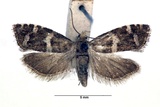Epinotia fraternana (Haworth, 1811) Species
Last modified: Nov. 29, 2023, 10:58 a.m.
A very rare and local species in Belgium. Not so often recorded.
Details
- Classification
- Family: Tortricidae > Subfamily: Olethreutinae > Tribus: Eucosmini > Genus: Epinotia > Species: Epinotia fraternana
- Vernacular names
- Gezoneerde oogbladroller (NL), Silver-barred Bell, Silver-barred Tortrix (EN), Tannennadelwickler (DE)
- Synonyms
- Epinotia proximana (Herrich-Schäffer, 1851)
- First mention in Belgium
- De Fré Ch. 1858. Catalogue des Microlépidoptères de la Belgique. — Annales de la Société entomologique belge 2: 45–162. On page 74.
- Status
-
Native
Distribution
Imago
Wingspan 10–14 mm. Very similar to Epinotia tedella, but differs by the tawny coloration of the forewing markings and the comparatively well-defined basal patch.
Caterpillar
Body light green, head, pronotum and anal plate light brown, brown anal comb present with 4-7 prongs, thoracic legs green, pinacula brown.
Mine
See also bladmineerders.be
Egg generally at the upperside of the tip of a needle. The larva spins a number of needles together in a more or less conical spinning, then mines out one needle after the other. The larva enters and leaves a needle through the same opening, mostly in the distal half of the needle. Most frass is ejected, part of it is trapped in the spinning.
Bionomics
Egg laid singly in June/July, usually near the tip of the underside of a leaf. Later, it mines the leaves at first, and later spinning leaves together, overwintering before pupating in spring.
The adults fly in the afternoon high up among the branches and later come to light.
Flight periods
The adults are on the wing from late April towards mid-July.
Observed on
- Host plant (species):
- Abies alba and Abies grandis
The larva feeds on Abies.
Habitat
It inhabits coniferous regions and isolated trees growing in parkland and mixed woodland.

